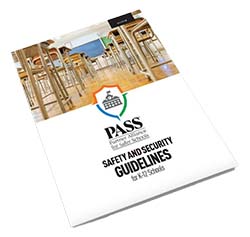
Where to Find Answers to Your School Security Questions
Schools grapple with many priorities—but the protection of students, teachers, and staff has risen to the top of that list. Many reports indicate that the country is seeing increases in school violence amid the unpredictable environment created by the pandemic, establishing an even greater need for schools to be prepared.
CEC has been helping schools improve security since the early 1960s—and when we heard there was more that could be done, we wanted to get involved.
There are lots of school security products on the market, making it difficult to wade through it all. With never-ending lists of systems and solutions to consider, where do you start—and how far do you go? What does your school really need in order to protect students and staff?
That’s exactly where the Partner Alliance for Safer Schools (PASS K-12) comes in. This nonprofit was formed in 2014 to answer the education community’s questions about school security. It also offers free resources like the PASS School Security Guidelines and School Security Checklist.
The partners that choose to become involved in PASS K-12 (including CEC) pledge to serve as school safety advocates who work daily to meet the needs of schools around the country. We go through training on how to use and apply the PASS School Security Guidelines and become trusted security experts who can get these recommendations into your hands. CEC is also part of a technical committee that weighs in on updates to school security guidelines and shares input about what’s working—and what isn’t.
A Tiered Approach to Secure Schools
The PASS School Security Guidelines take a layered approach to security. When I first heard this, I pictured medieval castles. The levels of defense they used to protect people behind castle walls are great examples of layered security in action.
If someone wanted to attack a castle, for example, then their first challenge was getting past the moat—and the defense layers kept going from there. This not only made access difficult, but also ensured continued protection if one layer was broken.
This tactic mirrors PASS’ approach to school security. Protection begins at the district level and property perimeter, working its way down to the classroom level, offering recommended best practices for:
|
 |
The guidelines take school size, location, and budget into account; they’re also technology agnostic, allowing schools to use whatever systems they need or want.
Why We Became PASS K-12 Partners
Every day, CEC observes the need for additional school security education and training. Last fall, for example, we were made aware of a school that initiated ALICE protocol in response to a nearby threat.
Once the ALICE alert was announced, students began to evacuate. The threat to the school was outside, however, which meant a lockdown procedure should’ve been followed instead. Although no one was in any danger as a result of this misstep, it’s a good reminder that regular drills and practice are necessary (along with technology that puts emergency response on autopilot to give the right messages to the right people in real time).
CEC’s team members are fully trained and invested in the safety and security of students, teachers, and staff. We’ve chosen to become security specialists to help our communities and schools stretch their dollars as far as possible so they can protect the next generation.
If school security is at the top of your list, then CEC can share valuable guidance—backed by proven PASS K-12 best practices. We can also walk through the School Security Checklist so you can compare your efforts to recommended processes and assess what you may need to change. Send us a note, and we’ll answer your school security questions!
Technologies:
Fire and Security

